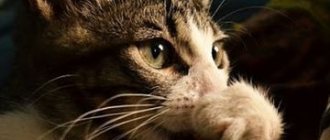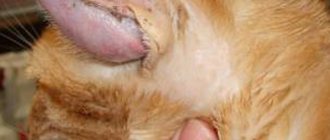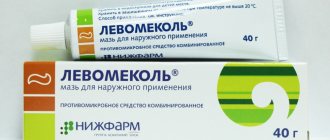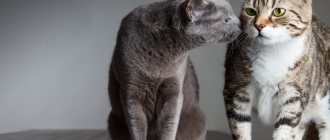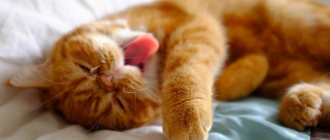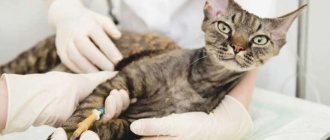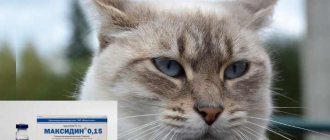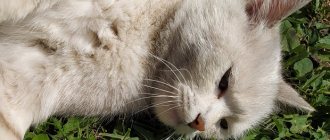Symptoms of a runny nose in cats
The external signs of the disease in a pet are similar to those in humans. The cat loses activity, is not interested in games, sleeps a lot.
Symptoms of a runny nose in cats:
- Discharge from the nose, the animal breathes with difficulty, only through the mouth, drooling.
- He often sneezes, coughs, and has an unkempt appearance. A sick cat neglects grooming.
- Tearfulness often accompanies a runny nose and can be severe.
- Decreased appetite or even complete refusal of food. If your pet does not eat for more than two days and even refuses water, this is a reason to urgently contact a veterinarian.
- The red mucous membrane of the mouth signals an inflammatory process.
- Body temperature remains high throughout the day. In healthy cats, it fluctuates depending on activity.
If the discharge festers, as in the photo, the disease is serious.
If you notice a runny nose, you should observe your pet before giving medicine.
A healthy cat in normal circumstances may have symptoms of a runny nose that are not associated with illness. It is necessary to ensure that there are persistent signs of illness before treating a runny nose in a cat.
Treatment of a runny nose in a cat with medications
When a runny nose is diagnosed, the animal is treated according to the following scheme:
- prescribing antipyretic drugs for fever,
- the use of drops, solutions to facilitate breathing,
- prescribing expectorants for coughs,
- taking vitamins to strengthen the immune system,
- prescribing antibiotics for complications.
Be sure to read:
The cat is coughing and wheezing, how to treat it at home
Commonly prescribed medications:
- Intranasal drops "Anandin" - stimulate the immune system.
- Naphthyzin nasal spray - used to rinse the nasal passages.
- Xylometazoline nasal drops make breathing easier.
The correct dosage is prescribed by the doctor.
Colds - causes, symptoms, treatment
When a person gets sick, he consults a doctor. The cat does not understand what is happening and cannot tell its owner. She just becomes lethargic and sleepy. The owner can help the animal if he notices dangerous symptoms in time.
Causes of a cold in a cat:
- The pet lives in cold and damp conditions with drafts. A comfortable temperature for a cat is + 20°C. If it is lower, the cat may get sick.
- Monotonous food without vitamins and microelements does not allow you to maintain immunity at the proper level.
- Hypothermia can occur if the cat gets its fur wet or in windy weather. In this case, the animal's thermoregulation is disrupted.
- If there is another disease, immunity decreases and the cat catches a cold easily.
Symptoms of a cold include discharge from the nose and eyes, coughing or sneezing, and not eating or drinking. Also, a cold is accompanied by a high temperature; the animal has a dry and hot tip of the nose.
You can support your pet by doing the following:
- leave the cat alone in the place in the house that she has chosen;
- provide clean drinking water;
- massage, stroking the cat, speeding up the blood and improving well-being;
- apply a warm compress with a heating pad if the animal has chills;
- Clean your nose and eyes with a cotton swab using cooled boiled water.
The listed actions improve the pet's condition.
To cure a runny nose in a cat, you need to rinse the nose with the medicine prescribed by the veterinarian.
The listed actions improve the pet's condition. To cure a runny nose in a cat, you need to rinse the nose with the medicine prescribed by the veterinarian. A simple remedy will do - a slightly warmed saline solution (sold at any pharmacy without a prescription).
Causes and symptoms
Sneezing and discharge in an animal can be caused by infectious and non-infectious causes. Depending on this, you need to build treatment.
Colds and hypothermia
Cats have a very high immunity, and colds - so frequent and even commonplace for humans - are rather an exception to the rule for an animal. Colds and runny noses are more common in homeless cats during periods of cold and rain. Colds occur for several reasons:
- The room is too damp, drafty.
- High humidity.
- Lack of vitamins, poor nutrition.
- Sudden temperature changes.
- The animal is hypothermic or wet (this can happen if the cat, for example, is not dried well after bathing).
Symptoms that will indicate a cold:
- Dry or, conversely, hot nose.
- Hair loss or dullness.
- Great lethargy.
- The cat sleeps for a long time or gets very scared of something that didn’t bother her before.
- Weakness (the animal stands well on its feet, but is apathetic), increased fatigue.
- Decreased appetite.
With a cold, breathing becomes difficult, the snot is clear and not viscous. The cat sneezes and coughs heavily, and the eyes may water. If discharge sticks to the muzzle or crusts appear, this means that the disease is becoming serious and may progress to the pathological stage.
An animal can breathe through its mouth to facilitate the process of obtaining oxygen, but if this happens constantly and the nose is not involved, you should immediately consult a doctor.
Allergy
If the animal sneezes, tries to constantly rub its eyes and nose, and discharge of a transparent texture appears from the eyes, most likely, we are talking about an allergic rhinitis. The snot in this case is liquid, transparent in color (odorless), and may be accompanied by swelling and dermatitis. Breathing is impaired and itching is likely.
REFERENCE
Cats can develop allergies to a certain product. After consultation with a veterinarian and tests, he will have to be ruled out. There may be allergies to medications, pollen, house plants, and even household items. Most often, the animal reacts to the irritant after several hours, but symptoms can appear several days after encountering the allergen.
Fungi and bacteria
Human ARVI, most often, is not transmitted to cats, but if the disease is caused by certain fungi and bacteria, then both the owner and the pet can become infected with a runny nose.
A bacterial infection is indicated by:
- unpleasant smell of discharge and its yellow-green color;
- accumulation of pus in the corners of the eyes or over the entire surface;
- snot from the nose and tears from the eyes;
- constant sneezing and coughing;
- the animal constantly swallows, this is due to the fact that mucus accumulates in the nasopharynx;
- body temperature rises;
- loss of appetite;
- dehydration;
- prolapse of the third eyelid.
Fungal infections overwhelm animals with weak immunity and often the runny nose becomes chronic. An indicator of a bacterial infection is a crust in the nose, which makes breathing very difficult and snot comes out of the nose.
Important! If the polyps have grown, the animal's face will become deformed. This is dangerous because the inflammation spreads to the brain; the symptoms of this are seizures.
Video about runny nose in cats:
Foreign bodies
Coughing and sneezing may be caused by a cat swallowing a foreign object in its intestines or esophagus. If this happens, the symptoms will be as follows:
- Profuse salivation.
- If a foreign body is in the throat, then coughing and wheezing appear, the tongue turns blue, and the cat may lose consciousness.
- Constant swallowing.
- Vomiting and belching.
- Complete lack of appetite.
- Bloating.
- Lethargy, apathy, drowsiness.
- Diarrhea, constipation.
- Symptoms of general intoxication.
Congenital pathologies
A runny nose can result from birth defects and injuries. For example, a “cleft palate,” that is, disturbances in the structure of the upper jaw and nasal bones, will cause the cat difficulty breathing and wheezing. Injuries to the jaw or head can result in a cleft palate. The bones can become displaced, and all this together will give the animal a chronic runny nose.
Important! If rhinitis does not go away for a long time or occurs periodically, be sure to contact your veterinarian.
With such pathologies, the discharge does not have an unpleasant odor and most often does not affect the general condition of the cat (if the injury is cured and is not life-threatening). To clarify the causes of chronic runny nose, you should contact your veterinarian. He will identify the pathology and tell you whether it is possible to treat it or eliminate the symptoms.
Inflammation (ears, teeth, gums)
A runny nose can be an indicator of inflammation that occurs in the nasopharynx or ears. And it will not go away until the initial inflammation is removed.
Why do cats get ear infections?
- Infections.
- Hypothermia.
- Other specific diseases.
Why gums and teeth can become inflamed:
- Malocclusion.
- Lack of vitamins.
- Caries.
- Tartar.
- Injury.
- Irradiation.
- Virus.
- Chemical poisoning.
With inflammation, the following clinical picture is observed:
- breathing quickens;
- discharge from the eyes becomes watery;
- the animal periodically breathes through its mouth;
- sneezing occurs infrequently;
- purulent snot, gray-green, whitish, yellow, sometimes even with traces of blood;
- loss of appetite.
Other causes of runny nose
Other problems that cause coughing, sneezing and sniffles include:
- Parasites, for example, worms.
- Tumor of the nasopharynx.
- Neoplasms.
- Chronic diseases.
- Infections.
- Stress.
Allergic rhinitis in a cat
Allergic diseases are caused by dangerous substances in food and air.
Symptoms of allergic rhinitis in cats:
- clear or colored discharge from the eyes and nose;
- dryness and redness of the mucous membrane;
- frequent sneezing, nasal congestion;
- lack of appetite, weakness;
- rubbing the nose with paws.
The reaction can occur to food, pollen and insect bites. The symptoms and treatment of allergic rhinitis in cats are determined by a veterinarian using a blood test. If you exclude contact with a dangerous substance, the cat’s illness goes away after two to three days.
Prevention of snot in pets
To prevent the occurrence of a runny nose in cats, you must comply with the following conditions:
- provide a balanced diet rich in vitamins;
- ensure that there are no drafts in the room;
- in the first eight weeks of life, immunize with Multifel-4, Quadricat, Nobivak;
- limit the cat’s contact with allergens and chemicals;
- do regular vaccinations to form stable lifelong immunity against dangerous viral diseases;
- Every six months, treat with anthelmintic drugs.
With timely measures taken, rhinitis in a kitten can be quickly cured if the cause is a cold or allergy. Severe bacterial and viral pathologies require medical intervention; delay can lead to the death of the animal.
Infectious causes of runny nose
The inflammatory process in the respiratory organs is accompanied by discharge. Clear mucus may become darker and have an unpleasant odor. In severe cases, blood is mixed.
Infectious types of runny nose and symptoms:
- Calicivirus. Runny nose with damage to the mucous membrane, high fever. The cat's eyes are watering. The disease is not dangerous for people.
- Rhinotracheitis. In addition to a runny nose, drooling, the animal does not eat, and moves little. Another name for the contagious disease is feline herpes, which is not transmitted to humans.
- Mycoplasmosis. Purulent discharge from the nose, swelling of the respiratory tract, swollen eyes. Serious complications are possible - inflammation of the lungs, liver, joint damage.
- Panleukopenia (another name is plague). Symptoms: runny nose, vomiting, upset stomach. The disease causes chronic complications on the heart.
- Chlamydia. Cough, snot and wheezing. The pathology is contagious to other animals; quarantine is necessary.
An infectious runny nose in a cat can be treated with antibiotics under the supervision of a veterinarian.
When prescribing a course, the cat’s possible allergic reaction to medications is taken into account, so you cannot select medications yourself.
Memo for the owner: what to look for
Rhinitis in cats, or an inflammatory process in the nasal passages, develops as a response to the influence of external factors on the nasal mucosa. The glands begin to intensively produce a protective secretion, a mucous liquid (runny nose, snot). When a secondary infection occurs, the serous-mucosal discharge becomes purulent.
Why does snot appear?
Nasal discharge occurs due to:
- Colds. When the body is hypothermic, walking in damp rooms with drafts, feeding cold foods.
- Allergies. Strong odors, fragrances, cigarette smoke, reactions to medications, parasite medications, etc.
- Foreign bodies
- Fungi, viruses, bacteria (rhinotracheitis, panleukopenia, mycoplasmosis, calicivirosis, pneumonia).
- Parasitic infections.
A runny nose as a symptom manifests itself when there is inflammation of the ears, congenital anomalies of the nasal septum, neoplasms, or when a cat’s nose is exposed to cold and hot air.
The breeder must pay attention to the presence of discharge from the nasal passages (snot) of varying consistency. A runny nose almost always goes away with lacrimation; the nasal passages are connected to the lacrimal canals. There is difficulty breathing, the nasal mucosa swells, the cat sniffles, sneezes, and rubs its face with its paws.
General symptoms of illness: apathy, anorexia, hyperthermia, lethargy.
Entry of a foreign body into the respiratory tract
While playing, a cat may accidentally get a foreign body stuck in its nose. More often, during sneezing, a foreign body comes out, but can get caught on sharp ends and lead to severe inflammation.
What foreign bodies enter the respiratory system:
- small items not intended for cat play;
- plant seeds, sand and garbage on the street;
- small insects;
- food particles or fish bones;
- eggs and larvae of worms.
A sign that a cat has a foreign body in its nose is a change in behavior. The animal often sneezes, shakes its head, and backs away. Nasal discharge comes with blood if there is a sharp object there.
You can find out what got into the cat’s nose by external examination or using an endoscope. The most reliable way is ultrasound, which will determine the location and size of the foreign body. The owner can remove the object with tweezers if it is located near the nostrils, otherwise surgery will be required at a veterinary clinic.
Polyps, growths and tumors in the nasal cavity of cats
The second most common respiratory tract disease in cats is nasopharyngeal polyps. These formations, overgrown areas of the epithelium, are dangerous because they continue to constantly grow.
Causes of polyps:
- chronic inflammation of the nasal cavity and inner ear;
- infectious runny nose in cats;
- allergic asthma;
- congenital defects of the nasopharynx.
Polyps are more often diagnosed in young animals under 2 years of age. The formations gradually grow from the nasal cavity into the ears, take on large sizes and prevent the cat from breathing and eating.
External manifestations of symptoms of the disease:
- discharge in the form of mucus from one nostril;
- sneezing and coughing;
- the pet snores and makes grunting sounds.
Polyps can be detected using an endoscope by feeling the soft palate with a finger.
Only magnetic resonance imaging can provide an accurate diagnosis, since soft tissues are not visible on X-rays.
Polyps are removed surgically under anesthesia, using forceps to grasp the body of the tumor along with the stalk.
Other causes of runny nose
The pet's immune system reacts to the onset of the disease. Microbes and toxins are removed along with mucus, which is how a runny nose appears. The causes of illness in cats living in the house are sudden changes in temperature, allergies, and frozen food.
Other causes of runny nose in cats:
- Tumors in the nasal cavity of different types. The external manifestations are like a runny nose, but the nature of the disease is different. Surgery is required.
- Viral diseases. Accompanied by high temperature and decreased activity of the animal. There is dark discharge from the nose.
- Age-related diseases - diabetes, kidney stones, heart failure - cause chronic runny nose. It is impossible to completely cure such a disease.
- Fungal infection of the nasal cavity. Surgical and medical treatment is required. Advanced disease leads to deformation of the skull bones and even death.
- Otitis. It can cause a runny nose, as it is inflammatory in nature.
- Congenital malformations of the nasopharynx, crooked septum. Surgery will correct the deviation.
- Acrid odors irritate the mucous membranes and cause swelling. It is necessary to provide your pet with clean air and peace to recover.
There are cat breeds that suffer from rhinitis more often than others. British and Scottish Fold cats regularly suffer from runny noses due to the shape of their ears and nose. Therefore, owners should systematically show their cat to the veterinarian.
What diseases does snot in a kitten indicate?
Blood in a cat from the anus, in a cat and a kitten
A runny nose in cats can be primary, as a result of hypothermia, an allergic reaction, or feeding with cold foods. Secondary rhinitis is a concomitant symptom of viral and bacterial diseases, parasitic lesions, and congenital malformations.
Cold or viral infection
Colds in kittens are often accompanied by a runny nose. The immune system of babies is imperfect. Hypothermia and allergies can lead to the syndrome. Weakened kittens with poor nutrition and crowded living conditions are more likely to get sick.
Discharge from nose and eyes
The greatest danger for small pets is viral diseases accompanied by rhinitis. Small kittens are not vaccinated against severe viral pathologies.
Note! Lack of contact with sick animals is not sufficient protection. A viral feline infection can be brought from the street on clothes or shoes.
The most dangerous viral diseases of kittens with symptoms of a runny nose:
- panleukopenia - mortality reaches 50%;
- calcivirosis - mortality reaches up to 30%;
- rhinotracheitis - mortality reaches up to 30%.
With a cold or virus, the nasal discharge is thin, the eyes become watery, and conjunctivitis often occurs.
Suspicion of a viral infection requires immediate contact with a veterinarian.
Polyps, processes and tumors in the nasal cavity
Polyps are benign formations in the form of epithelial growths. Often appear in young individuals from four months to two years. The causes may be hereditary genetic mutations and a reaction to chronic inflammation in the nasopharynx.
The impetus for the appearance of polyps can be:
- viral, bacterial and fungal pathologies;
- congenital malformations of the nasal passages;
- allergies, asthma.
Nasal polyps in a kitten are accompanied by the following symptoms:
- nasal discharge, sneezing;
- noisy breathing, snoring;
- head shaking.
Note! Without treatment, polyps grow and can completely block the flow of mucus from the nasopharynx. Sick animals breathe through their mouths and refuse food and water.
Polyps can grow into the middle ear and cause inflammation. Early diagnosis and timely surgical treatment alleviates the kitten’s condition.
A foreign object got into the nose
The entry of a foreign body into the nasal passages is accompanied by profuse salivation and frequent swallowing. The kitten has a runny nose. Usually the body gets rid of the foreign object on its own, sometimes requiring the help of a veterinarian.
Bacterial infections
One of the reasons when a cat has snot is the activation of pathogenic microflora: streptococci, staphylococci, various types of mycoses.
Thick nasal discharge caused by bacteria
Inflammatory diseases of bacterial origin:
- catarrhal rhinitis;
- chronic inflammation of the sinuses;
- lobar inflammation of the nasal passages.
An exacerbation of the disease occurs when the animal’s immunity decreases.
Parasites
With a parasitic infection, snot in a cat is not the only symptom. There is a deterioration in the general condition and inflammation of the lymph nodes. The pet behaves restlessly: sneezes, shakes its head, rubs its body against objects.
Allergy
The appearance of dyes, flavor enhancers, and chemical cleaning agents often causes a runny nose in allergic kittens. Pedigree cats, which have lower immunity compared to their mongrel counterparts, are especially often affected. There is profuse discharge from the nose and the eyes are watery.
The most common allergens:
- chemical compounds included in animal feed;
- impregnation of a flea collar;
- household chemicals;
- dust, mold;
- pork, chicken, eggs;
- cereals.
Snot in a cat with allergies is a common occurrence.
Important! In rare cases, an allergic reaction develops at lightning speed and can threaten the baby’s life. During an attack, you should carefully monitor the kitten to prevent swelling of the larynx.
Diagnosis of rhinitis
If your pet shows obvious signs of illness, the cause must be determined before treatment. Rhinitis in cats is diagnosed at a veterinary clinic.
Steps to find out the causes of a runny nose:
- Physical examination – external examination and diagnosis using an endoscope.
- Laboratory tests of blood and urine to determine the nature of inflammation (bacterial, viral).
- X-rays allow you to examine the shape of the nasal cavity and foreign objects.
- Mucosal smears are examined for microflora. The type of pathogen is determined to prescribe a treatment regimen.
The more detailed the examination, the more effectively you can cure a runny nose in a cat. Without treatment, the animal acquires chronic diseases that cause irreparable harm.
Symptoms and diagnostic features
Symptoms that may accompany rhinitis in a pet:
- lacrimation;
- discharge of mucus from the nose;
- lethargy;
- decreased appetite;
- increase in body temperature.
If the symptom is triggered by an allergy, then itching, swelling and redness of the skin and mucous membranes may additionally be present. Bacterial rhinitis is characterized by purulent nasal discharge. In this case, the animal often develops a fever and practically does not get up. The introduction of a viral or fungal infection is also accompanied by copious mucous discharge from the nose and fever.
If, in addition to a runny nose, the cat is itching, this may indicate an allergy.
If parasites are present, the symptom does not go away for a long time and cannot be treated. Additionally, a cough may develop, appetite may worsen, and the pet will lose weight. With congenital anomalies in the development of the nasopharynx, a runny nose is present from the very birth of the kitten and accompanies it throughout its life.
What research methods help identify the cause of rhinitis:
- Allergy tests. This diagnostic method allows you to identify the provoking factor. To do this, small incisions are made on the pet’s skin, then various types of substances are applied and the reaction is monitored. This method is relevant only if the allergic nature of rhinitis is suspected.
- Examination of the nasal cavity. This type of study allows you to identify a foreign body or tumor. In this case, the doctor uses a special optical instrument.
- Blood and urine analysis. This method makes it possible to determine the inflammatory process, diabetes mellitus, and other diseases by characteristic signs. With abnormalities in the blood, the level of leukocytes, erythrocyte sedimentation rate and the amount of glucose increase. Protein and stone crystals may appear in the urine. In addition, the urine becomes cloudy and may contain bacteria and fungi.
- Skin examination. If the doctor detects any abnormalities, he may additionally perform a scraping to identify fungal microflora. A Wood's lamp is also used, with which it is easy to detect microsporia and other lesions of the epidermis.
- Stool analysis. This study allows you to identify parasite eggs and helminth fragments that can provoke the appearance of symptoms.
- Ultrasound of internal organs. This method of examination makes it possible to exclude damage to the kidneys and digestive organs and to identify possible disturbances in the functioning of the heart. If there are a large number of parasites in the pet’s body, they can be visualized in the intestines in the form of dark spots.
An important method is an examination by a veterinarian, which will identify the first signs of dangerous pathologies.
Attention! If a runny nose is a consequence of diabetes or tumors, then the animal’s condition only worsens over time, and standard treatment methods remain powerless.
Treatment of runny nose in pets with medications at home
With a mild course of the disease, when the pet’s condition is satisfactory and there is no bleeding, you can treat a runny nose in a cat yourself. The pet is placed in a warm place without drafts. Treat the eyes and nostrils with an antiseptic, and remove dried nasal discharge with a cotton swab.
Treatment methods for various types of runny nose in cats:
- Mild runny nose without fever. Instillation of zinc sulfate, inhalation with soda or saline solution is used. Use Streptocide in powder form or instill Anandin.
- Infectious rhinitis is treated with moisturizing drops of Galazolin and Doxycycline tablets. In case of severe runny nose with difficulty breathing, droppers are given and medications are given to support the immune system.
- Allergic rhinitis in cats is treated with antihistamine tablets, just like in humans, you just need to follow the dosage.
- If foreign bodies get into the nose, it is necessary to instill moisturizing drops into the cat, and if the object is within reach, remove it with tweezers.
If the remedies used do not produce results, or the pet’s condition does not improve, you should urgently contact a veterinary clinic. Delaying treatment will lead to complications.
How to treat at home if your cat is sneezing
You can treat an animal at home if a veterinarian has conducted an examination, ordered the necessary tests and identified the true cause of the cat’s sneezing. Pet owners, when identifying an allergic reaction in their pets, often ask the question: what to do if the cat sneezes due to an allergy? In this case, the cat is prescribed antihistamines to alleviate its condition and eliminate the allergen.
If the cause of sneezing is polyps, then they can only be removed surgically in a veterinary clinic.
During an asthmatic attack, the animal is prescribed vasodilators, antispasmodics, and corticosteroids.
If the cause of sneezing is diseases of the teeth and gums, the animal’s teeth are treated, tartar is removed, inflammation of the gums is relieved, and vitamins are prescribed.
Gingivitis and tartar in cats
How to treat if a cat is sneezing and has snot? This question is most often asked by owners of animals with a cold. The animal is prescribed anti-inflammatory drugs, nasal drops, and vitamins.
In the case of an infectious disease confirmed by laboratory tests, antibacterial and antiviral drugs, nasal medications, and immunomodulators are prescribed.
The oncological cause of sneezing in cats can only be eliminated by surgical removal of the tumor and chemotherapy.
Non-traditional treatment of runny nose in cats
You can cure your pet of rhinitis and colds using home methods.
Traditional methods of treatment:
- Warm compress. Heated salt in a fabric bag is applied to the nose. The discharge is removed with a cotton swab. Warming is allowed only in cases where there is no purulent or bloody discharge.
- Washing with an antiseptic. Solutions of soda or salt with a volume of 0.5 ml are poured into the nose with a syringe without a needle. The solution is prepared at the rate of 1 tsp. salt or soda per 250 ml of water. To prevent the cat from resisting, wrap it tightly together with its paws in a diaper.
- Plant drops. Beet juice or aloe leaves is instilled. You cannot drip pure juice - you need to dilute it in half with boiled water. It is enough to inject 1 drop into each nostril 3-4 times a day.
- Inhalation with eucalyptus decoction. 1 tbsp. dry collection is boiled for 15 minutes in 0.5 liters of water. They insist for half an hour. The cat is wrapped in a diaper and held over the steam for 10 minutes so that it does not get burned.
- Pouring Streptocide powder into the nostrils helps to quickly relieve inflammation and stop the formation of pus.
- Rinsing with a warm solution of Furacilin.
Flowing snot and tears irritate the skin, so you need to wipe your nose and eyes with strong tea, and then sprinkle with Streptocide powder.
A cat loses its appetite when it is sick. To speed up recovery, offer your pet his favorite food warmed up.
Treatment
Since a runny nose often becomes only an indicator of a viral infection or other inflammation in the body, it will be necessary to treat not so much it as the root cause. It is not always possible to independently find out the true source of the disease. Therefore, it is very important to consult a veterinarian, conduct a diagnosis and follow the treatment plan.
It will be very difficult to cure a stray cat from a runny nose if he is not provided with comfortable conditions: warmth, food, vitamins and scheduled medications.
Useful video on how to put drops in a cat's nose:
Colds and rhinitis
If your cat's cold cannot be treated at home, then you need to seek help from a veterinarian. The clinic will examine the cat and prescribe the necessary medications. It is not recommended to use medications without a prescription from a specialist. Typically treatment includes:
- Taking antipyretics if the temperature persists.
- Expectorants.
- Antibiotics.
- Vitamins.
- Droppers (to avoid dehydration).
Drugs used:
- Maxidin. Drop into the nose to stimulate the immune system.
- Anandin. Antiviral and immune system stimulant.
- Naphthyzin together with Dioxidine. Nasal rinsing.
- Galazolin. Drops to ease breathing.
One drop of the drug is instilled into each nostril. The course is from five days to a week. You can rinse your nose with zinc sulfate (2%), boric acid (3%), a mixture of Methanol and fish oil.
Other means: “Maksidin”, “Derinat”.
Important! Never use “human” drops, they can aggravate the situation and cause irritation of the mucous membrane.
Allergic runny nose
Irritation in animals is caused by food and non-food allergens. The most common of them:
- Beef or pork.
- Chicken, chicken eggs.
- Cow's milk.
- Corn, wheat (other cereal grains).
- Potato.
- Carrot.
- Dust.
- Mold.
- Hygiene products, household chemicals.
- Irritant from a flea collar.
To cure an allergy, you need to accurately and in detail describe the symptoms to the doctor; it is advisable to note what exactly the cat reacts to and for how long. They do a blood test and scraping. Antihistamines and corticosteroids are most often used for treatment.
The house needs to be treated with insecticides, and the animal must be isolated from the allergen that causes the reaction. If you cannot immediately find out what exactly is causing the disorder, you must remove as much as possible all household chemicals, medications, cosmetics, etc. The room must be cleaned and ventilated frequently.
If the allergy is accompanied by itching, the doctor will prescribe a special ointment, shampoo or gel. Sometimes steroid hormones and immunotherapy are prescribed (a small amount of the allergen is injected into the blood so that the body gets used to it).
If you have an eating disorder, you need to follow a diet. For example, use hypoallergenic food. When the symptoms go away, the previous foods are returned to the diet, checking the animal’s reaction. If the runny nose recurs, food allergens should be categorically removed from the animal’s food forever.
Viral runny nose
Among viral infections, rhinotracheitis, calicivirosis, mycoplasmosis, chlamydia and other infections cause a runny nose. And although they differ, the treatment regimen is approximately the same for everyone. The main thing is to contact specialists in time. You cannot cure a viral infection on your own; only a veterinarian can prescribe the exact dosage and duration.
Serum or globulin is used to create immunity - the drug VITAFEL, vitamins and probiotics, replacement therapy.
Immunostimulants:
- Roncoleukin.
- Derinat.
- Neovir.
- Gamavit.
Antibiotics are required. They are drunk for at least five days, most often from a week to ten days, one to three times a day.
- Macropen.
- Baytril.
- Neopen.
- Cefazolin.
- and others.
Treatment at home
For treatment at home, nasal drops are used, for example, children's nasal drops - one in each nostril daily. You can rinse your nose with a hypotonic solution: a teaspoon of sea salt in warm water (half a glass). The mucous membrane is also washed with a solution of tannin (0.5%), soda (1% solution). Streptocide powder is blown into the nasal cavity or two drops of ecmonovocillin are dripped into each nostril (it is diluted with saline 1:2).
From folk remedies, rinsing with beet juice is suitable: 1 part juice to 3 parts water. Aloe juice from the cut is collected into a pipette and dripped for three days. To rinse, you can use boric acid (draw the liquid into a syringe without a needle, drop it into the nostril).
You can do inhalation: take a bowl of hot water, drop eucalyptus or other oil into it, and place the container near the animal.
Possible complications after rhinitis
It is necessary to treat a cat’s runny nose, otherwise there is a risk of consequences:
- chronic bronchitis and pneumonia;
- renal dysfunction, urolithiasis;
- chronic disease – plasmacytic rhinitis;
- lymphocytic gingivitis - damage to the oral mucosa;
- persistent decrease in immunity - the cat often gets sick;
- damage to the cornea of the eye - can lead to blindness;
- formation and growth of polyps - surgical removal will be required.
An advanced disease and late seeking help from a veterinarian lead to complications after a runny nose. Self-treatment at home can also lead to bad consequences.
Prevention of runny nose in pets
Proper care will protect your pet from serious illnesses and ensure a healthy, long life. Actions to prevent a runny nose:
- Timely vaccination to protect against the most dangerous infections.
- No drafts or dampness. Keeping your pet warm. Do not dry wet wool with a hairdryer.
- Balanced food with added vitamins to maintain good immunity (Pro Plan, Sirius, Hills Ideal Balance).
- Removing possible allergens: changing the brand of litter, frequent wet cleaning, getting rid of indoor plants. Using hypoallergenic food (Brit Veterinary Diet, Acana Pacifica for cats, Brit Care Lucky I'm Vital Adult).
- Once every six months - treatment for worms (preparations Profender, Milbemax, Prazicide).
The owner's attention, care and timely treatment will give the pet a long and happy life.
